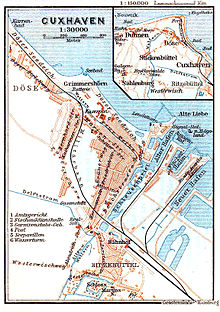Cuxhaven tram
The Cuxhaven tram , also known as the Cuxhaven City Railway , was a tram in the city of Cuxhaven , which at that time belonged to Hamburg . Since the line was owned by the Navy and led from the Cuxhaven train station past Fort Grimmershörn to Fort Kugelbake , it was popularly known as the cannon train . The train could only be used for four weeks. It was subject to the reservation "that operations should be stopped immediately as soon as the Navy reports its own needs."
history
The five-kilometer route was built in 1899 to transport weapons and ammunition. In 1911, the city's magistrate held initial talks to set up a tram on this route. In 1912 the navy was also included in the negotiations. Since the laying of their own tracks and the establishment of a trolleybus route were considered too expensive, the route to the fort was repeatedly considered. After the Navy formulated its requirements in 1913 to allow operation, the city council decided with a large majority to introduce the tram.
Used vehicles of the Schmöckwitz – Grünauer Uferbahn were initially intended for operation. Although these vehicles were operated electrically, they were equipped with a so-called benzene motor for power supply, which generated its own electricity using a dynamo . The construction of a carriage hall was put out to tender on March 19, 1914. The approval of the city of Hamburg was granted on May 5, 1914 for a period of ten years. In late May, the city also received provisional military approval. The contract stipulated that operations should be stopped immediately as soon as the Navy announced its own needs. In addition, the city was obliged to build the sidings and sidings at its own expense and to assume 80 percent of the maintenance costs. The opening was planned for the beginning of the bathing season. The vehicles arrived on June 17th and driver training began on June 24th. On July 6, 1914 at 6:22 a.m. the tram service started on a section.
The travel time of the train was between 13 and 15 minutes, it served a total of 15 stops . On August 2, 1914, the outbreak of the First World War stopped the tram. After the end of the war there were no longer any interested parties to resume operations. On December 19, 1919, a bus line was set up on the route. The cars were sold to the Moerser Kreisbahn in 1921 .
During this time, the railway had earned 6969.10 marks and thus exceeded expectations.
Web links
- History of the Cuxhaven tram on johannes-kroeger.magix.net
- Stadtwiki Cuxhaven about the "Städtische Bahn Cuxhaven" with lots of pictures and route map
Individual evidence
- ↑ Joachim Kubig: 70 years of Schmöckwitz-Grünauer Uferbahn . In: Verkehrsgeschichtliche Blätter . Volume 5, 1982, pp. 118 .

